#inkling and octoling biology
Explore tagged Tumblr posts
Text
So according to the first Splatoon direct, Inklings can actually freely change their skin and eye colors. At first I thought it was odd, then I remembered that IRL squids and octopuses can change the color and/or texture of their skin and such.
One has to wonder if it's done using the same method, and whether or not it applies to their ink colors as well.
I hope I'm not being captain obvious lmao
4 notes
·
View notes
Text
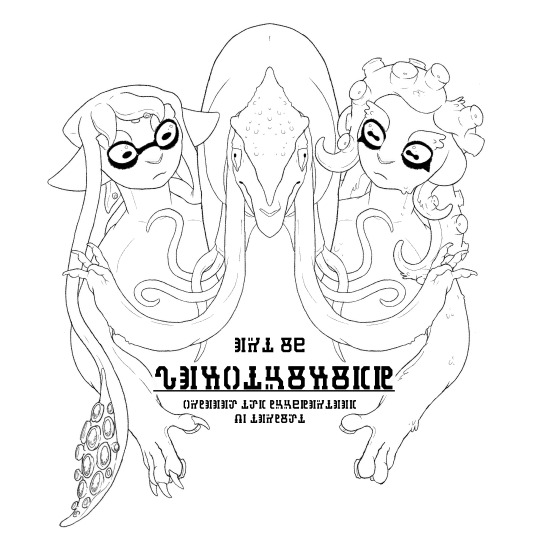

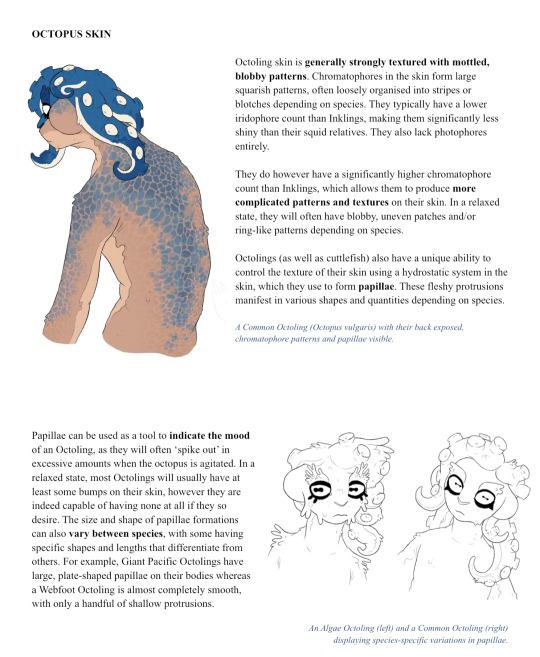
HEY! Do you guys like squid biology? creature headcanons? cool art? well BOY do I have the document for you~~!
It is with great pleasure to show off this absolute chonker of an art/writing project; The Mollusc Era! BEHOLD, MY MAGNUM OPUS!
In this document I go over the intricacies of various cephalopods; Inklings, Octolings, Cuttlings and even the Nautilus! The entire study is illustrated by yours truly, so there's plenty of pretty pictures to gawk at as well as pages upon pages of my concentrated autism ramblings to pour over if that's also your thing. Enjoy!
I’ve also included a Legacy Version of the document: a much older, unfinished version complete with ancient-ass art from mid last year in all of its poorly-rendered glory. A lot of the information in there is also outdated and poorly written, so good luck with that. yuck.
I recommend viewing both of these on desktop as the formatting seems to work best on there. You're more than welcome to use any of the info in there for whatever you like, if you're gonna use my art please credit me though! cheers!
#This has been over a year in the making it's finally DONNEE#this was a project made purely for selfish reasons but hopefully the internet likes it as much as I do lmao#my art#splatoon#xeno tag#splatoon art#my writing#speculative biology#speculative zoology#spec evo#splatoon 3#splatoon fandom#inkling#octoling#squid#octopus#xeno inkling#xeno octoling#splatoon fanart#spec zoo#spec bio
829 notes
·
View notes
Text
Splatoon artists, how creature are your inkfish?
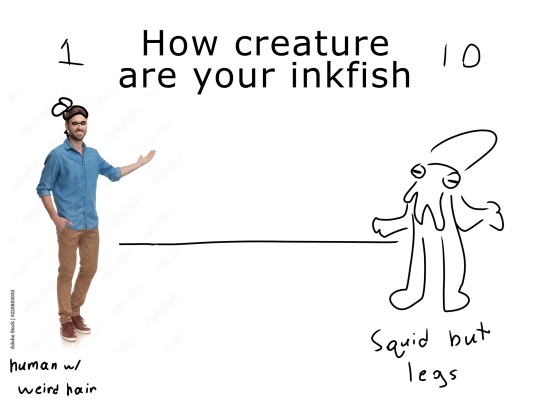
It’s crazy the variety of how people draw inkfish, so here’s a little game :)
Reblog and put in the tags, and if you’re not an artist you can put how you imagine inkfish
(For an example, canon would be about 2 due to some features like the beak/mouth and fingers being stylized)
#splatoon#splatoon art#splatoon fanart#inkling#octoling#xeno inkling#spec biology#splatoon 3#splatoon 2
1K notes
·
View notes
Text
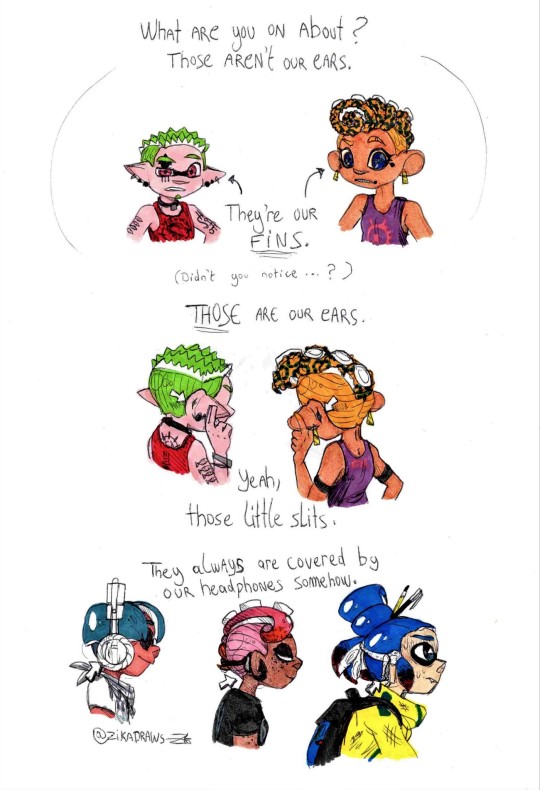
POV : you just complimented two young punks about their ear piercings and they thank you by schooling you to hell and back
-Long story short ; I have a feeling that since they have no visible eardrum hole to actually serve the hearing function, the inkfish "ears" aren't actually their ears, but the humanoid version of their fins ; or more accurately of the floppy bits on their heads from their original species.
So they aren't actually ears, but they're used for fashion, conveying emotions (they can move them more or less consciously, much like a cat), and also and mainly for protecting their actual ears, located behind them, from weather conditions (like wind or sand storms), from direct impact during fighting circumstances, and from currents, like when they swim.
Their headphones are actually always designed to somehow cover the little slits that are their actual ears. (The fins play as mere structural support then.)
...This is a theory of mine that just kinda jumped in my face when thinking about how Inkling ears are completely flat, and even if it isn't going to stop me from drawing their fins like actual ears, it's cool to have an explanation about that design. Hope you like it too 🤗
(Also side note but I love coming up with random Inkfish designs when illustrating this kind of stuff. Enjoy heavily tattooed Inkling guy, blue-ringed Octoling with the toupee tentacut and OctoGirl with lesbian flag-themed tentacut. Happy Pride.) (:
#splatoon#splatoon 3#splat3#inkling#octoling#xeno inkfish#xeno inkling#splatoon headcanon#character design#scanner#theory drop be like 💨#anyway enjoy#neo agent 3#splatoon biology
1K notes
·
View notes
Note
I wanted to clarify about the inkfish's blood color? I was told there is a bit in the latest art book confirming they have red blood but i am yet to see a source so i wanted to ask
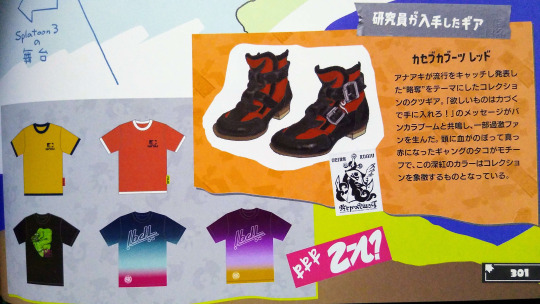
Gear acquired by our researchers Red Hammertreads Anakki has caught on to the latest trends, and has presented a collection of "looting"-themed footwear. The message of "Take what you want by force!" resonated with the boom of rough and rugged Splatlandian fashion, creating some die-hard fans. The motif of the collection is a gangster octopus, which has turned deep red due to the blood that's risen to its head.** This deep crimson color is symbolic of the collection.
**頭に血が上る means to be agitated or excited, but literally something like "blood to rise to one's head". with all the mentions of dark red, this word choice connecting it to blood was deliberate so i left it in.
Turning red due to agitation in this case might be implying its like a deimatic display rather than literal blood, but regardless that is still a connection of red blood and octopuses.
regardless of if you want to take this as solid proof of inklings/octolings having red blood, there are some other things that hint at them having red blood. like this art showing some inklings with ears and noses tinted red from the cold:

or this concept art for an inkling anatomical model, with the insides tinted red

There's also how the inside of the mouths of the squid sisters is a fleshy pink/red color rather than a color connected to their ink color, but theres some weirdness with how consistent mouth colors are If you're thinking, "but wouldnt it make more sense for them to have blue blood because they're cephalopods?" this is what i thought too. While blue blood is fine for sea dwelling cephalopods to have blue blood, it's inefficient for carrying oxygen for land dwelling creatures. Inklings and octolings took on many adaptations to make them more suited for land, so why not their blood? If the concept of a mollusc evolving from having blue to red blood sounds farfetched, this exact thing has happened to ramshorn snails!
Other option is they literally have ink blood which *shrug* idk they are creatures of Flesh and Organs so Im inclined to believe they have actual blood that, like the organs, we don't see because Family Friendly Game . I mean, we know for sure salmonids have actual flesh and blood (you can literally buy their meat in mako mart) but in game they just kind of explode like ink bags. anyway in short: not explicitly confirmed what kind of blood inklings and octolings have but with the S3 artbook and these few other examples i think red blood is a real possibility.
#splatoon translations#splatoon lore#splatoon headcanon#asks#biology#inklings#octolings#i have more headcanon thoughts about inkling organs and anatomy but i dont want this to be too long so i leave it here
297 notes
·
View notes
Text
I gave all the eye colors in splatoon 3 genotypes.
I am not a geneticist, just someone who thinks heredity and genetics are fascinating. Below the cut are pictures of all eyes colors + their genotypes + the genotypes written out for those that need it!
Inkling Models <- image(s) source
Before we dive in, a few quick things that will make this easier to understand!
* indicates a mutation! M-D means “mutation dominant”, meaning it occurs when either a homozygous dominant + heterozygous dominant, and it means that the mutation would be dominant over homozygous recessive pairs but not hetero itself or homozygous dominant pairs.
Example: Xx* is not more dominant than Xx or XX. Xx* & Xx have the same level of dominance!
M-R means “mutation recessive”, meaning the mutation occurs on a homozygous recessive pair. The M-R is not more dominant/recessive than the non-mutated gene.
Example: xx* is not more dominant than xx. They have the same level of dominance.
And lastly, mutations only “sit” or are carried on the second allele.
GENOTYPES
Listed in order of dominance. I tried my hardest to give every gene set an homozygous dominant, heterozygous, and homozygous recessive but it didn’t work out 100% perfect.
BB - dark blue (homozygous dominant) BB* - dark blue iris & pupil (mutated homozygous) Bb - turquoise (heterozygous) bb - light blue (homozygous recessive) YY - gold (homozygous dominant) YY* - dull mustard (mutated homozygous dominant) Yy - yellow (heterozygous) yy - light yellow (homozygous recessive) yy* - pale yellow w/ glassy pupils (mutated homozygous recessive) PP - purple (homozygous dominant) PP* - dark purple (mutated homozygous dominant) Pp - light purple (heterozygous) pp - powder purple (homozygous recessive) GG - dark gray (homozygous dominant) Gg - gray (heterozygous) Gg* - brown (mutated heterozygous) NN - dark pink (homozygous dominant) Nn - dark pink w/ blueish irises RR - red (homozygous dominant) Rr - red (heterozygous) HH - hazel (homozygous dominant) rr* - pink iris & pupils (mutated homozygous recessive) nn* - pink iris & pupils (mutated homozygous recessive) albinism - the 3rd & final way to get the pink eyes. albinism overrides other eye color genes.
PHENOTYPES (IMAGES)
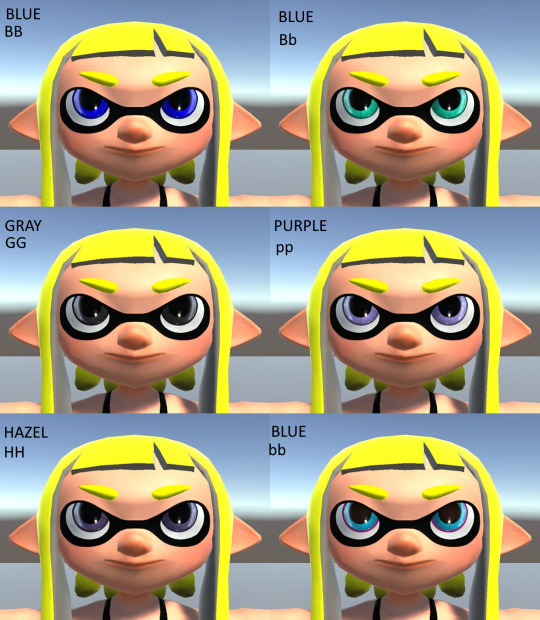


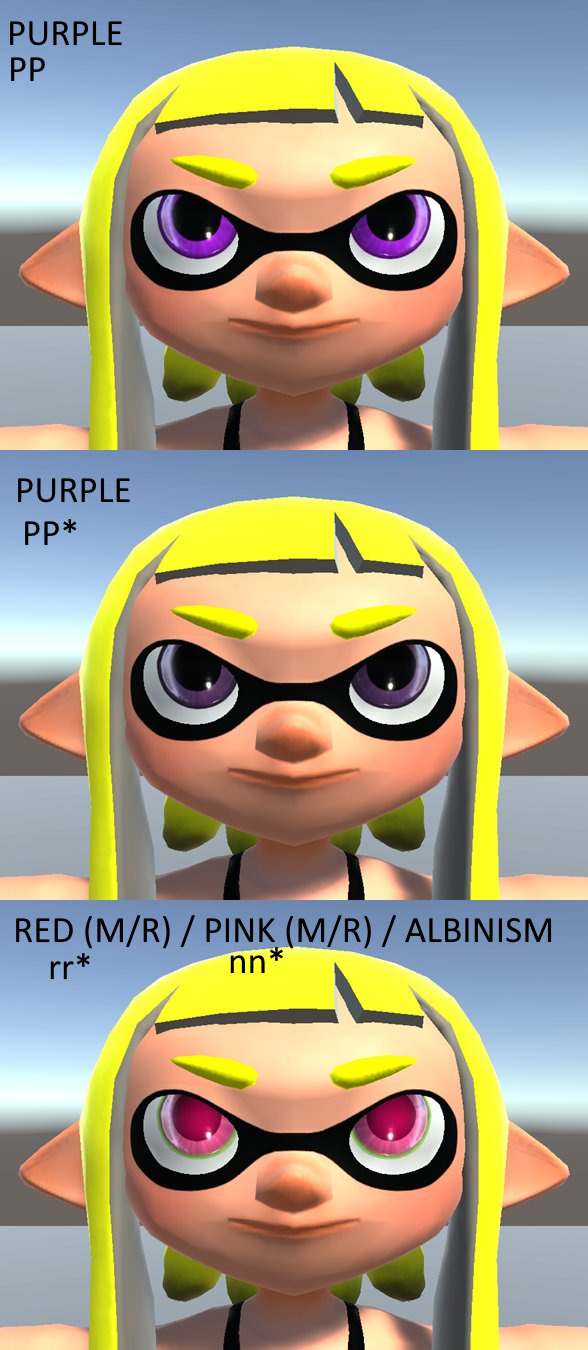
#genetics#splatoon#splatoon 3#long post#splat3#I love genetics so much#images#eye contact#<- maybe? just wanted to be safe 👍#speculative biology#maybe??#inkling biology#the same would likely apply for octolings#also the albinism genes works like it does in humans#AA Aa aa. you get the vibe
22 notes
·
View notes
Text
I'm really curious to see what's most popular, at least on Tumblr ^^
#splatoon 3#splatoon#inkling#octoling#octarian#splatoon lore#splatoon biology#inkfish#splatoon 2#polls#fun polls#fandom poll#prism
30 notes
·
View notes
Text

grahhh some spec bio things
10 notes
·
View notes
Text

ive heard the theory of the inkling eye mask being like sun protection quite a bit over the years, I think its both! I just think the changes in texture and the repeated cases of “ink gushing from eyes” is too weird to ignore. the out of universe reason for the eye masks has been explained: --I think a main point of the Inklings is the black area around their eyes. Did you have this design in mind from the beginning? It reminds me of something like Bloopers from the "Mario" series. Inoue: It's not like that because of Bloopers. It was inspired by the black makeup that punk rock musicians wear around their eyes. --So it doesn't have much to do with them being squids (laughs). Inoue: I thought that a bit of a rough attitude, similar to a just-debuted rock singer, fit this game. This is how that mood turned into an image. Nogami: People have their own opinions about the design, whether it's cute or creepy, but I think the worst thing that can happen is that people are not interested. Even if people don't like something, it is possible that something will trigger a reversal of that opinion, so I try to create designs with hooks, rather than bland designs, so that people will be interested.
OK look at the inkling eye mask. I thought they were like a thin singular black line, but on closer inspection they have this crinkly almost cracked looking texture. I'm imagine it feeling very dry and almost rough.
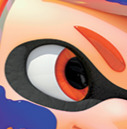



3K notes
·
View notes
Text
Is there a particular reason why people's art of more "realistic" (as realistic as anything in Splatoon can be anyway) inkfish tend to have claws? Some octolings have pretty sharp looking fingers but claws in that sense seems more like an amniote (mammals, dinosaurs etc) trait. I'm just curious
#they often have a bit of canine appearance with a muzzle too#i must admit im not good at cephalopod biology#splatoon#splatoon 3#inklings#octolings#my posts
1 note
·
View note
Note
what's the home run au?? pretty please infodump!! /genpos /nf

The HOMERUN au is what I want to call a Salmonid and Inkling swap au, but eventually became so convoluted it’s now it’s own separate thing.
I’m glad this ask exists because I will be using it as a pseudo pinned… until I get that… figured out… ⛩️ thank you! I’ll be splitting the main ideas into parts, (and chances are any unanswered questions will be answered later! I want to explore this au in little lore tidbits, so please be patient with me! But don’t be afraid to ask!)
Idol / Agent lore will be explained in mini comics and posts… :] but as for what the Homerun au actually is…?
I’ll explain everything under the cut!
THE GREAT TURF WAR:
During the Great Turf War— inklings and octolings were at a horrible stand still, resources and morale is low due to the two warring species exhausting themselves. The waterline rises high (WAY higher then canon) wiping out the lands they’re fighting for and reducing the habitable lands into waterlogged territories that are too dangerous and flood-prone for either species to survive… the war ended with Salmonids on the rise, dominating the lands, and nearly wiping out both species thanks to the ocean and the brute strength and resources they had.
Because of this inkling territory is very small— but still succeeded in claiming land, unlike the Octarian, which were forced to retreat to the wastelands— the wastelands are devoid of life, but worse, flooded and horribly weathered.
Relationships between the warring species goes as this: Politically, all of the species are enemies, but at this current state, have no real reasons to continue fighting.
Salmonoids are trying to “mend the relations between Cephalopods and Salmonids”— at least that’s what they’re saying. They make efforts such as propaganda pieces, but their biology(see “anatomy” column) Is far too different from cephalopods to properly live together. They mostly push this effort towards Inklings— half because they are the species that utterly despises them, and the other half as a power play. A few Salmonid Company’s that control the local politics have a few ideas they want to use to control inklings, but it’s no use if they’re not allies.
Octarians still see inklings as the species that drove them out, despite salmonids being the unlikely winner of the war, Inklings are the ones that claimed the only slightly habitable lands, so they are the adversary.
Octarians are still an ally to the salmonids, their industrial mega cities are often seen as “barbaric” or “frightening” to most species, but the Octarian see them as war-strong allies who they desperately need to learn off of. Octarian culture has vastly evolved to accommodate Salmonids— this has changed most Salmonid’s(within the public) understanding of inkling/octoling biology for the better. Having survived off their trade / resources, every Octarian issue becomes a Salmonid issue, and vice versa, these two groups are closely intertwined.
Inklings are enemies with the Salmonids, but due to their loss in the war they were forced to truce— Inklings are the only species that do salmon runs, so they see Salmons at their most aggressive, and in turn are taught to view them as monsters, despite the species affinity towards politics, business, and other relations they’ve made public— they only see them as language-less inkling-murdering monsters. Because of their hatred of salmonids— they yearn to rekindle the relationship with Octarians.

It’s a real “be my ally” love triangle. But truly, Octarians and Salmonids are BUDDIES!
THE MAP
Inklings are doing better, they still construct Inkopolis in this au. Inkopolis is prone to flooding, but it’s still plenty safer and operates much like it does in canon (with the same stores and such!). The city is now equipped with many functions that keep it’s citizens safe from flooding. Flooding is less common in the plaza as opposed to the outskirts of the city. Inkopolis is a staple location, proof of survival and glory, the place every kid said they wanted to move to when they got older.
The Octo-Canyon + Domes still exist here, but the surrounding area is nearly all water, so resources are scarce and its difficult for them to survive on their own. They thrive on trade, and what can only be described as “for-hire agent work” for salmonoids and other wasteland neighboring species. Their technology was forced to rapidly advance to accommodate for this.

The area right to Inkopolis, where Calimari County would lie, are sandy (sort of beach-swamp esque) farm lands. The towns are rural distant areas, perpetually flooded, sort of resembling low tidepools, it’s pretty gorgeous lands . They primarily farm seaweed here, as well as cultivating other sea animals and rice grain.
The area above New Inkadia— in the Wastelands— is similar, farm lands and small villages, but to note: more Salmonids are here, and the inklings here speak Salsegal (the language salmonids speak) and here Salmonids and Cephalopods engage in this reverse salmon run.
The Wasteland inklings cultivate and raise Zapfish, most are young and unable to power full cities, and so Cephalopods in this zone have (as a result of water damage affecting HOW they retain ink) developed a new type of ink that is able to act as an electrical current— these types of inklings/octolings are known as KRAKENS, and Salmonids occasionally enter these areas and capture this electric ink technology since it’s on their turf, and they can’t use their eggs out of respect, Zapfish are in low supply, and in turn, Inklings collect power eggs.
AC TOKYO is a city built on the idea of mending the relationships and creating a society where all species can thrive! And oddly enough, the city and decor is described as historic… due to all of the designs looking very… human. The reason for this is unknown. (Wink.) (DEEPSEA METRO rests underneath it.)
NEW INKADIA is where splatoon 3’s locations lie! Though under a different name, and a very different appearance, and ALTERNA is a secret project that has created an entirely new society that consists of both Cephalopods and Salmonids… at the expense of changing them.
Alterna is where DEEPCUT appear.
ANATOMY
How salmonids and inklings function is plenty different from canon
Inkling’s skin is incredibly paper-thin fragile, but extremely reliable, it is made up of trillions of individual parts that collapse into a thin membrane that essentially splits all of the insides into even tinier parts when coming into contact with a certain chemical signal that triggers the “transformation reaction”, allowing their skin to collapse into Ink Puddles, and as a result allowing it to reform into the Swim Form. So essentially, when Inklings are in the “puddle form”, they are a super thin nearly invisible sac carrying all of their super small broken apart organs, and reforming is just these broken apart cells very quickly attaching back together to either shape into Kid or Squid.
When a cephalopod gets “splatted”— all that’s happening is that there’s either too much stress, or too many injuries, or there’s a drastic shift in the amount of ink the subject is currently carrying, causing them to Self Destruct, as inklings are safer when the cells are broken apart, it’s harder to damage larger parts of the inkling IF they are broken into tiny parts that cant be broken apart any further.
“RESPAWNERS” aren’t actually “a place for the ghosts of inklings to land to revive”— this is a myth, and plenty easier to explain.
Respawners are attached onto the ground in inky turf grounds, and they cycle through ink at an extremely fast rate. Most turf battles have a very small layer of water or ink on the ground to allow respawner to filter ink— in doing this, the respawner are drinking in a shit tone of ink in order to suck up inkling puddles that carry near invisible flesh sacs thanks to Inkling’s weird skin membrane. And in the respawner, they’re refreshed with new ink and injected with a chemical that shakes them awake, quickly waking up a splatted inkling inside the respawner.
During Salmon Runs, the sight of Inklings who are missing limbs on the battlefield returning the next day to attend a shift with no visible injuries isn’t uncommon. As long as the cells still exist within the membrane, they can be rapidly rebuilt and regenerate.
But, despite all of this, Inkling skin is incredibly weak to water, this membrane that can carry collapsed organs, severed limbs, and gives the signal that allows inklings to transform— can melt and collapse and can permanently damage if coming into contact with too much water. Water against this skin-membrane is similar to water on a tissue, melting into it, and splatting the inkling— but because there is now a tear in the membrane— it affects how the inkling is able to heal, how quickly the inkling can recover, how much ink the inkling can now retain, or if it’s possible to transform after the injury. Membrane Water-Damage scars can vary, but they are all regarded as dangerous if left untreated too long. Since small holes can be treated and taught to heal over, but left in water, can cause these holes to grow too large for the membrane to function as intended.
In fact, even overly HUMID environments can wear on inkling skin overtime; which is a problem for cephalopods and salmonid relations.
Salmonids have gills, but are amphibious, and in the adult (not spawning, spawning Salmons have very different anatomy, I will go into salmonid life cycles below) stage of their growth, they require air to thrive. Hence, needing land, but because they have gills, they require humid environments or close by water in order to keep the gills moist. Or else they could dehydrate and suffocate.
TLDR: inklings+octolings need dry environments so they don’t die from overexposure to humidity/water, Salmonids need wet humid environments so they don’t suffocate to the lack of water.
SALMON RUNS, and the LIFE CYCLE:
During salmon runs, you collect eggs, and in the warehouse, fertile eggs are seperated from infertile eggs, and are shipped back to Salmonid cities.
In salmonid cities, the eggs are sorted, genetically tested, and are given a name— the reason why salmonids have such long names is because the eggs are named by the title of the clans of their origin, and the families then extend the titles via new names or traits.
Having children isn’t a decision that can be made on a whim, since it requires traveling to a salmon run grounds in a race to these lands that allow both parents to officially breed in what’s known as a “HOMERUN,” but unlike IRL salmon, the need to return home is NOT a requirement or a hormonal change, but rather a decision, and the transformation into spawning-forms is a result of the journey.
Most parents have hundreds of eggs, and hundreds of children, but most of the time— in salmonid culture, only those who are considered “high status” are selected to “bring glory to the clan name” and go on these homeruns, most common folk don’t.
Salmonids are in a way socially (a tad culturally) aromantic, in a way, since they don’t have any desire to find a special someone never sprung into existence, especially since relationships initially begin as a concept due to the act of having children, but to salmons, it is viewed as a business decision. So romance is nearly non existent. (Again, socially, not emotionally, but the concept is still very much foreign.)
All salmonids are orphans in some way or another due to the parents dying in the Homerun (it’s extremely rare for a parent to return, if they do, it’s most likely they won’t survive the transformation back into a non-spawning form— which is why those who do survive usually remain in homerun grounds.)
The offspring are given back to the clans of parents of the children, not as eggs, they leave them to develop and once they become “SMALL FRY” they are given to the families.
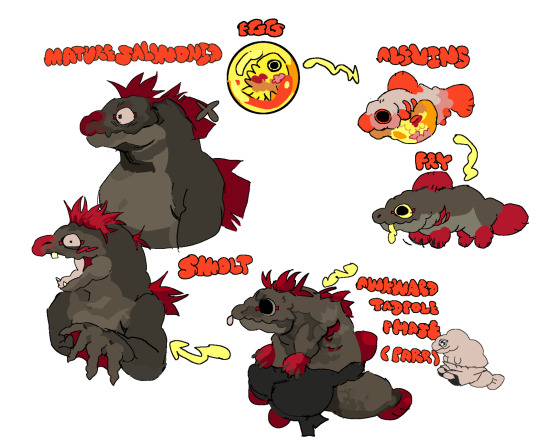
THE EGG- power eggs, power houses, even infertile eggs are still high wattage batteries.
ALEVINS- you will most likely never see these few, in the wild, they grow up in the water and feed off the power egg.
FRY- they begin to grow lungs and muscle, they start to come onto land and use their fins as hands, if only slightly. They still are stronger swimmers than they are walkers. This is the stage in which they begin to swim home, they aren’t very good learners due to this form expending all energy in strength in order to travel and survive.
AWKWARD TADPOLE PHASE! - their fins grow into hands, and they slowly learn to walk. You see this stage at around four or five years old. This is considered the most important time in thier lives, because as FRY, they were running on instinct more than anything, so this is the time when their brains truly start to develop. Their head fins sort of fray, splitting into a growing head fin and a dorsal fin.
SMOLT- The phase between Tadpole and Nearly fully fledged salmon, their hands begin to fully form, they have more canine teeth that begin to grow in as teenagers. Fingers are webbed! The dorsal fin grows in. Most teenagers are still a tad hunched, but otherwise have no issues standing upright.
MATURE SALMON- Dorsal fin is fully developed, and they stand without a hunch.
In order to have offspring, they HOMERUN, and doing this transforms them back into waterborne species to accommodate for the vast journey. Their arms turn into fins, this change is far too jarring and aggressive for the species to live long after this.
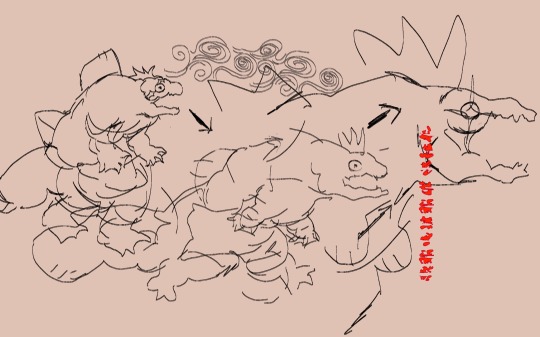
SALMON RUNS ONLY EXIST BECAUSE INKLINGS HAVE DISTURBED THE NATURAL PATH THAT SALMONIDS NEED TO TAKE IN ORDER TO HAVE OFFSPRING. They intend to enter the aggressive phase at the river, before reaching the end mid land, but because inklings occupy this land, they’re forced to remain in these aggressive stages.
The slaughter of the spawning season salmonids is not a part of the cycle that salmonids worship so thoroughly. But, Salmonids were designed to die during this phase, and they never grew to be revolted by this idea— but that is not the reason why.
A Grizzco partner company named SENSHINCORP. that specializes in Cephalopod/Salmonid Trade, Safety, and Relations has taken control of the public’s opinion of the neighboring species.
(it’s a persuasive warning shot that makes every species doubt the opinions they feel they should have. It’s the reason why new paths weren’t created for Homerun Salmonids, POWEREGGS are big buck business, and it’s best you don’t pry.)
Okay, final section:
GRIZZCO. (+SENSHINCORP.)
Grizzco functions the same, a company that thrives on exploiting desperate job hunting inklings, and exploiting a culture that relies on the glory of dying.
But, this time, Mr. Grizz remains in contact with Senshin Corp, a salmon operated company that thrives on the tension between salmonids and cephalopods.
Salmo-San owns Senshin Corp, he’s a friend. He only wishes the best.
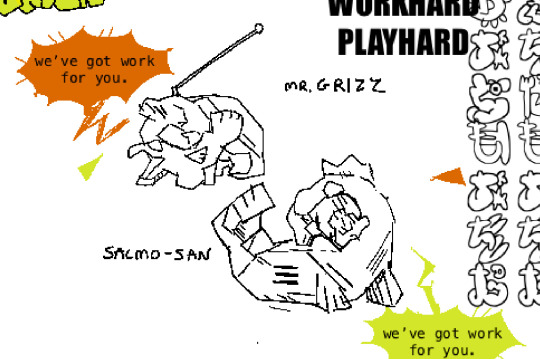
210 notes
·
View notes
Note
I know that Inkling societies mirror human ones because of plot reasons going back to Alterna, but I've really enjoyed seeing your 'convergent evolution' takes on the biology, so why not apply that same logic to something like, say, architecture? At a glance, sure, Inkopolis and the Splatlands look recognizable to us, but would for instance an inkling or octoling's home have a layout differently built for their unique needs and behavior?
Thank you! also yes this is a good point! I've been avoiding doing anything too outlandish with the architecture or much of any of the worldbuilding to be honest because we know very little about Splatoon architecture and... well, stuff like this, to begin with. And it's harder to try and change major things about the world itself than it is to work with alternative biology for a creature in my opinion; all we really know when it comes to architecture and city- and building design in Splatoon that it is very similar to those of humans, and a lot of the elements are based on modern day Japan. I doubt the developers are doing that much to differentiate the architecture from human buildings and stuff because granted it would be a ridiculous amount of thoughts and work to sculpt a society and buildings that accommodate like 500 different species MINIMUM.... there's some little things here and there, like the Giant Doorways in the Deepsea Metro, but then there's other things like the freaking escalator in Inkopolis Plaza that's literally the width of maybe 1 Inkling and no other species even fits in that. Hell, it's not even the width of TWO PEOPLE which is at least expected of escalators to my knowledge--- anyway....
my point being I don't like to make sweeping differences to human architecture when it comes to Splatoon, because whether I like it or not a LOT of their stuff is just human architecture a little bit to the left. But that doesn't mean you can't make any changes to it, and it also doesn't mean there aren't any changes, those changes just might not be as visible.
Some random things I've thought about: Modern housing in Inkadia has VERY strong windows. Glass in general is very strong in urban environments, especially buildings near Turf War areas for obvious reasons... you don't want people Super Jumping through your window nor your window blasted to smithereens by a Trizooka shot that missed.
In apartment buildings, if there are mail slots on the doors, there's a container on the other side. Prevents people from slinking into your house through the mail slot. Apparently this is a common thing to have in Japan? We just have mail slots or postboxes out in the yard or lobby.
Also to prevent people from slinking into your house: residential buildings have dense grates, nets or spikes in their ventilation shafts. In some older buildings and non-residentials, these might be missing. But without things like this, any Inkling (typically) can just fit straight through a pipe as long as their beak fits in it, so you would end up having guests you maybe don't want.
Quickly about apartments; they're actually a very popular form of living not just for cost-cutting and because there's a fuck ton of residents in Inkadia, but because inkfish are mostly very social and do better surrounded with lots of people living in close quarters. The two most popular types of apartments are single-person ones that are basically just a single-room hole, and bigger apartments that have several small rooms and a community area that are meant for a whole school of squid (usually a friend group) to live in. People who live in the single-person apartments typically just go home to sleep and maybe cook or something... unless you're an introverted squid, or not a squid at all, and just settle for very little when it comes to space.
Inklings ALWAYS have some type of direct heating in their houses, from space heaters to a kotatsu to heated blankets to sun lamps. This is because Inklings are mostly cold-blooded and become very sluggish if their body temperature falls too much (for example from lack of physical activity or from cold room temperature), so there's a focus on keeping one's living quarters comfortably warm. Most lamps marketed for inkfish are actually heat lamps to the point where finding a lamp that Doesn't Make The Room Hot if it's on for too long is kind of hard.
Inklings are pretty vulnerable to dry air due to their thin skin and dependence on humidity to keep them thoroughly hydrated. As a result, you'll find air humidifiers in like, every house. In some AC units, a humidifier function is included. From a human perspective, the average Inkling apartment feels warm and humid - but to them it feels just normal. Due to the relatively high humidity, it's pretty common for electrical outlets to have covers for when they're not in use.
It's common for Octarian homes to have "sleeping holes" or "dens" carved into the wall. These haven't really become trendy in Inkopolis yet, but they probably will. It's also quite common for inkfish homes to have stacked furniture and interior made in layers - because they can fit in very tight spaces in swim form, maze-like interiors are still fully usable to most inkfish. Though it's rarer to find people who actually want to deal with the clutter.
Most Inkopolis bathrooms have a combined shower-bath. Inkfish showers come with a shower head that only really lets mist through on the default setting. (You're expected to test this BEFORE you take your first shower and replace it if necessary because you don't want to get into the tub and then find out it's a normal cross-species shower head on fucking Jet Mode.) Bathtubs are mainly used for re-absorbing moisture and soaking in ink rather than cleaning (because inkfish don't do very well with actual baths).
Most flooring is specifically made to be ink-resistant and non-absorptive. The combined humidity of the air and the ink that inkfish naturally get everywhere would ruin wooden floors IMMEDIATELY.
Toilets usually have a flap or gate blocking the drain that flips open when it's flushed. There are too many historical cases of people falling into toilets and just fucking dying or going missing forever because it's difficult to get out. (Mostly kids, but also people who fell asleep or too far into thought and just slinked into there. The world is full of danger when you can fit into any gap.) also lots of people accidentally laying eggs there which for obvious reasons is REALLY BAD if there's nothing to catch those.
All modern apartment buildings are required to have elevators. I'm pretty sure this is also just a real-life requirement nowadays. A lot of older buildings in Inkopolis don't have any, though... and while Super Jumping on street level is usually prohibited, most apartments have roof access, so a lot of people still jump between work/hobbies and their house. It is A LOT faster than dealing with traffic or walking (but it's also mostly illegal).
uh probably more things. My brain is empty now but hopefully that's some kind of inspiring ty for asking!
173 notes
·
View notes
Text
HI HELLO! Welcome to my completely unnecessarily detailed analysis on how I think Inkfish languages could work! + with art! yay! This is all pretty rough and not fully fleshed out (I don't have the time or patience for that lmao). THIS IS A LONG POST.
Okay, so there's dozens of languages spoken by cephalopods in the Mollusc Era but the main two I'll talk about are Inkling (or Inklish) and Octarian, spoken mostly by Inklings and Octolings respectively.
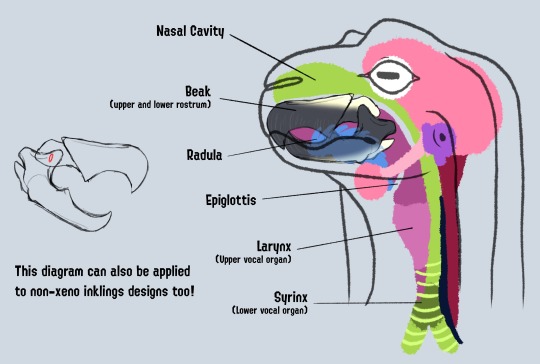
In cephalopods, speech is formed using the syrinx and larynx, two fancy vocal organs that most other species don't have together. The larynx makes sounds using the radula (tongue) and vocal folds in the throat, it's clear and pretty easy to understand as the sound itself resembles human speech, albeit warbled. The syrinx makes noise by vibrating air at the base of the trachea, it's often trickier to follow as it can sound more like droning background noise than words sometimes.
An inkfish can use both of them at once, resulting in an EXTREMELY complicated language system where words can be made up of multiple layered syllables, and several words and sentences can even be said at the same time.
As you can probably imagine, all of this is LITERAL HELL to learn for species who don’t have both a syrinx and a larynx (so basically anyone who isn't a cephalopod). But fear not! There are many simple and more inclusive alternatives, dialects and other cool stuff like sign language and instant TTS technology for people who physically can't pronounce Inkling/Octarian or even vocalise at all (eg. jellyfish).
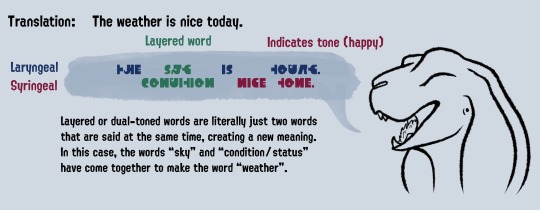
Both main Inkfish languages can be broken down into laryngeal words (made with the larynx), syringeal/drone words (made with the syrinx) or a combination of both, called dual-toned/layered words.
Keep in mind that both word-types can be spoken at the same time. Layering can be used to add additional connotations to a word, or to even make a new one entirely. For example, the laryngeal noun ‘bird’ combined with the syringeal noun ‘metal’ spoken together will create the layered Inkling word ‘aeroplane’, like a compound word in English.
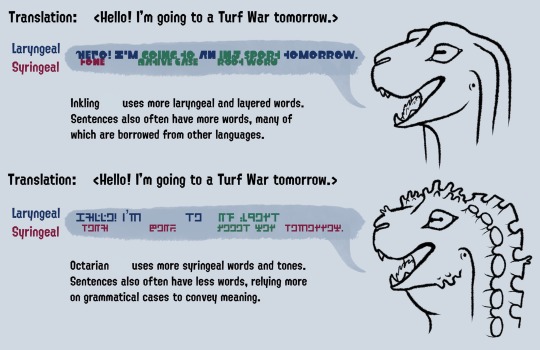
Dual-toned stuff is more common in Inkling than in Octarian, as the language is older and has more loanwords. Inklish's dependence on the larynx gives it a higher-pitched, clearer sound whereas Octarian's more monotone syrinx-based structure results in a deep, almost guttural sound.
Both cephalopod languages are heavy on tone and pronunciation, resulting in a plenty of accent indicators in written scripts. I used the in-game fonts for the art but if I were to rework it, each letter would probably be more complicated than traditional Mandarin on steroids. So hell on earth, basically.
On a side note, all of these language features open possibilities for some very cool poetry and literature. An inkfish author could write a poem with two lines of thought occurring at once, or a book with vivid emotional undertones written inside the prose. Pretty cool.
OKAY that's all I have to say thank you for reading! Hopefully this makes sense, feel free to send asks or whatever if it's confusing and I'll do my best to explain it better!
#I should go outside instead of analysing the silly squid game#I tried my best with my scientific and (limited) linguistic knowledge don't yell at me if I get something wrong lmao#my art#splatoon#xeno tag#xeno inkling#xeno octoling#splatoon 3#splatoon art#speculative biology#speculative zoology#conlang#splatoon headcanon#inkling#octoling#splatoon theory
604 notes
·
View notes
Text
A lot of things I got dragged into sploon, no matter how I enjoying Salmon run (because teamwork and fun day)
So I decided to draw the content
Here's line up agent in my design looks-
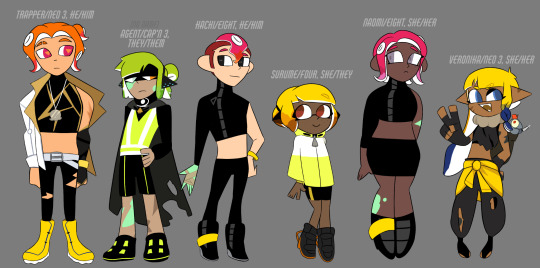

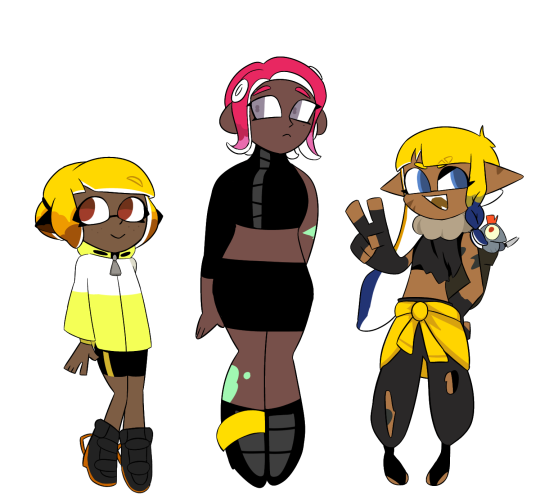
Just for the toon style looks, so here's a hcs for each agents:
(Long words)
Trapper, 22 y/o [Species: Octoling??]
Trapper is not just an octoling, he was used to be one of the Kamabo experiment no.5150. Because he was saved by her adoptive mother, Ellie, he always have to hide his identity in the event of Splatoon 1. He doesn't know much about Dj Octavio and the Octarians clan, but he seems interested until the event of Splatoon 3. He doesn't talk, but he can use sign language (it's a sign that he's mute as always and it's because his voice is very likely to human languages and has no bubble effects in it like the other octolings. He's not an only child he was raised by her own mother, he has a sister, Veronika. He doesn't trust the Kamabo or Commander Tartar. He has a strong relationship with Four, but now he miss her (since they became separated and getting worried about her). And also, he's a gardener.
Veronika, 14(splat 3) - 16(now) y/o [Inkling]
She's a little feral and always care for his older brother. Never been join Grizzco industries because her little salmon buddy is afraid of the boss himself. She's a huge fan of Pearl from the Off the Hook. She interested any type of weapons and a mechanic engineer. Being forced to washed herself, since she's smell like fishes belongs in the sea. She's also a best friend of Murch. If you mess with Trapper, you mess with her (she'll forced you to drop yourself in the sea as an threat or eats gross food).
Agent/Captain 3 [No name], 21 y/o [Inkling]
Has slowly lost their original name and gender. Became tired and depressed because of the Octo expansion event, but still smiles when think about the past what they used to. They like Naomi as a close friend. rarely talks and type of introvert person. Doesn't want to talk about Deepsea Metro (they have PTSD). They can rap since they known as DJ Sango. Get along with the Squid sisters, even they stay as their part of the family. Always support other Agents no matter what and only the mysterious agent among others.
Surume/Four, 23 y/o [Inkling]
A great agent who always very positive and an extrovert person. She always like Trapper, who are very close to her (both always think about each other since they were separated from different city). She was busy due to an extracurricular, and a roommates with Hachi and Naomi. Four really care about Trapper's feeling for her if he's not in a good mood. She loves biology to know about sea creatures and even mammals, including plants. She's shorter than other agents.
Hachi/Eight, 21 y/o [Octoling]
An agent who is only one was escaped from the Deepsea Metro with his sister, Naomi. He doesn't get recover his traumatic experience back there, but always finds a way to avoid it. Kind to anyone, likes other agents. He doesn't know about Trapper, but he interested to meet him. Confidence to find answers. He's afraid of C.Q Cumber. When he's stares at you, it can tell he looks like a little puppy. He and Naomi lives with the Off the Hook as like their parent figure. Always protect his sister.
Naomi/Eight, 19 y/o [Octoling]
She's a bit shy and a fan of the Squid sisters after the effects of the Calamari Inkatation. She likes Cap 3 about their skills and being cool. She's barely talks, but always needs a help from her brother. She kinda loves the beautiful view around the new city or places she wants to travel. She's having a fear of Blender and being lonely without her brother or someone. She likes doing art and doodles on her sketch she bought in the surface. She always sticks with her brother since she doesn't want to get separated. And a friend of Four.
Welp that's all the hcs I have for my agents. Most of them are similar the canon splatoon facts. And here's the base of the body type looks
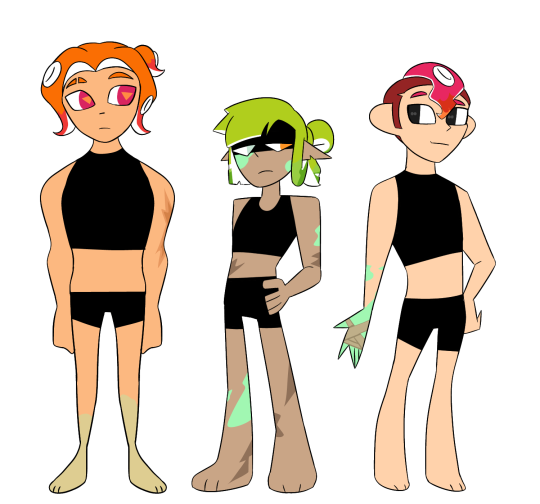

And bonus for Trapper in agent outfit:

#tdh's art#splatoon#splatoon 2#splatoon 3#splatoon agents#agent 3#captain 3#neo agent 3#new agent 3#agent 4#agent 8#trapper#splatoon oc#trapper has different outfit if curious why; because the previous one doesn't suit him or he's big and can't zip it then it got ripped
61 notes
·
View notes
Text
Happy Pride Month 🏳️🌈🏳️⚧️...check out Splatoon!!🦑🐙
Splatoon is so diverse when it comes to sexuality and gender. Don't believe me? Here's a list:
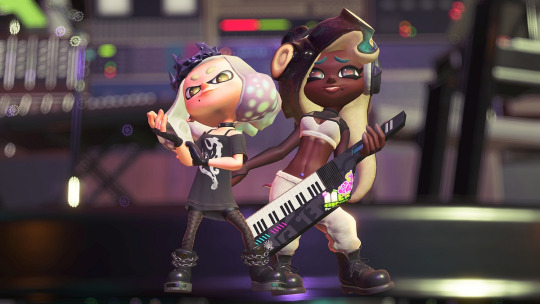
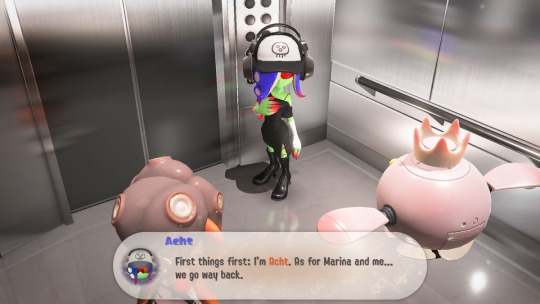
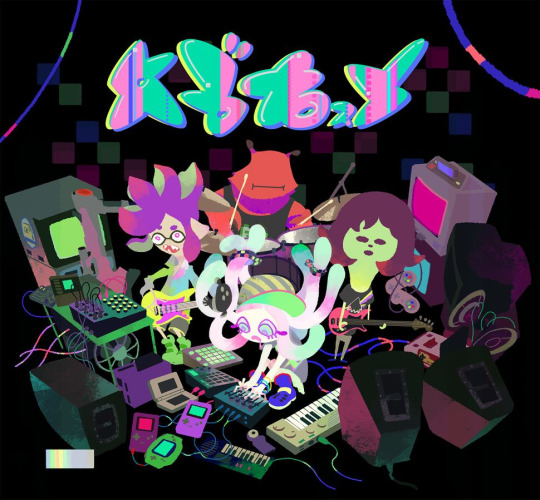
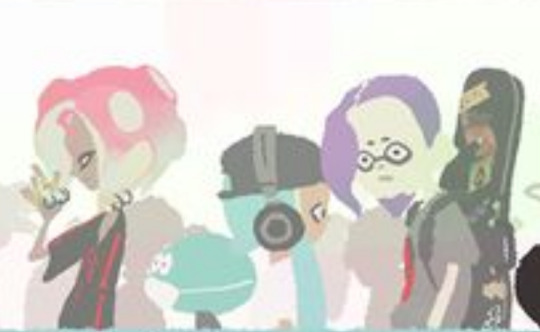
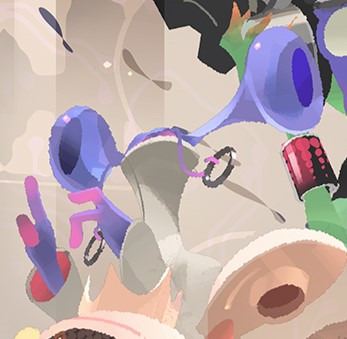

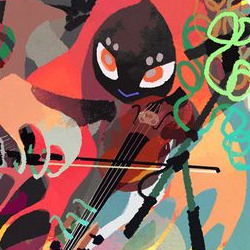

Pearl and Marina, also known as Off the Hook - the most unsubtle non-confirmed lesbian couple (but it's pretty much canon by now). Check out this post full of evidence!
Acht - the series' first major confirmed nonbinary character, using they/them pronouns, correcting mistranslations from both official sources and fan translations. (Also commonly headcanoned as aroace or other variations, based on their reactions to romantic scenes between Off the Hook)
Orion (the green one) - nonbinary character from the supporting cast, confirmed by this dialogue from their friend. (Only video I could find of the dialogue in quesiton)
The band Diss-Pair - commonly headcanoned as a gay couple based on the fact that they appear in the Valentine's Day artwork for 2019 (by extension, the giant group in the front can be a polycule, if you really want them to be)
Cipher...
And
6. Smollusk - ^ both characters who use it/its pronouns. Listed on their individual wiki pages.
7. Finn - a presumed transgender female fish if we think about real life betta fish biology.
8. Shiver - initially speculated to be nonbinary, based on their pronouns in the Japanese version. Later confirmed to be female in English.
Some of these are more canon than others, but let's just have fun regardless, yeah? And celebrate what we do have!
Some more things I can think of:
Craig Cuttlefish and DJ Octavio - popularly headcanoned as the 'textbook definition of old men yaoi lovers to enemies 🎵'
Agent 24 - popular ship between Agent 3 and Agent 8 (3x8=24, math puns!), due to promotional art + 2020's Valentines Day Artwork. (The characters often change in gender in appearence in promotional artwork)
Multiple ships between the games large cast of female characters
Removal of gendered hair/clothing options in Splatoon 3.
Various same-sex ships from the spin-off manga, Coroika.
Multiple of the above pairings listed are Inkling/Octoling ships (Squid/Octopus) - a reoccuring theme in the game is the opression of Octolings, mirroring real world issues of discrimination and 'forbidden love.'
Jumping off from that middle point, the game is female-centric (with lots of female characters + the default for the playable character being female-presenting), as the developers discuss in a 2015 Famitsu interview:
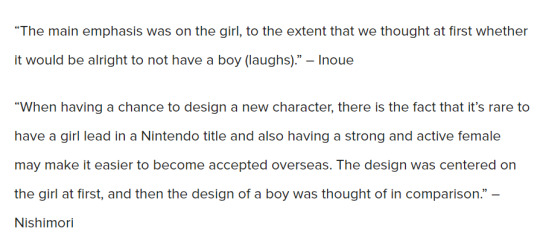
Splatoon has always been a franchise where hopefully people can see themselves represented in game, particularly young girls. As the franchise develops, more and more diverse characters are added for this exact purpose.
This is an amazing series where hopefully all sorts of people can feel represented in one way or another!
Sorry if I got any details about any of the characters/events wrong - I'm going off of my memory and observations about the fandom, mostly. I just really wanted to share these facts with everyone! You're welcome to share your own intrepratations and facts in the reblogs too! :) Let me know if I missed anything!
Happy pride! 🏳️🌈🏳️⚧️🦑🐙
#splatoon#splatoon 2#splatoon 3#off the hook#pearlina#marina ida#pearl houzuki#acht#dedf1sh#splatbands#shiver hohojiro#deep cut#diss-pair#chirpy chips#bottom feeders#agent 8#agent 3#side order#side order spoilers#pride month#fandom culture#happy pride#lgbtqia
53 notes
·
View notes
Note
Hi!! I was thinking, what's your opinion about inktolings? Like I'm 99% sure they'll never be properly canon (due to various reasons including biology), but I wondered if you had any specific thoughts or headcanons about them. I'd love to know :')
in general, personally not a fan of the concept of hybrids in the splatoon world. if it were possible for stable hybrids to happen in a society comprised of so many species that have been intermingling for generations, i dont think we'd see the level of speciation that we do. it makes for messy worldbuilding.
inklings and octolings have had peaceful relations with each other for millennia and with how similar they look, i have zero doubt that some have tried for kids. but biologically speaking squids and octopuses as distant as cats and dogs (maybe even more distant than that, at least cats and dogs share a taxonomic order, squids and octopuses only share a class). the only way id imagine an inktoling to exist would be nothing short of a miracle, and would be sterile, likely with some kind of health issues. the sapient herrings in splatoon can produce hundreds of children and this likely applies at least to other species of fish too. for couples of different species who want children, i think there would be no shortage of children to adopt.
#asks#octolings#inklings#splatoon headcanon#society#biology#the splatoon world is scifi at its core and i like to imagine it as having some level realism and real world logic where it can#so imo having stable interspecies hybrids being a regular thing is just. too fantastical. and headache inducing to imagine how that works#should go without saying. me not being too much of a fan of hybrids in splatoon is not an invitation to shit on people who do like them
309 notes
·
View notes